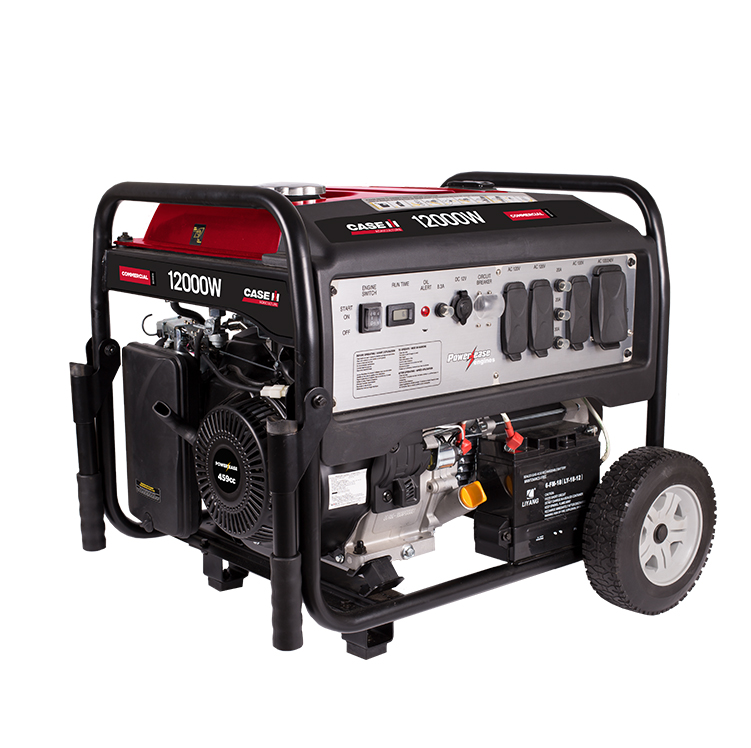Features of Generators and Inverters
These small machines create electricity making them critical for off-grid jobs and emergency power. They can also be found in leisure activities such as camping
and fishing.
How is electricity created?
Portable generators take stored chemical energy such as gasoline, which is used to run an engine. The engine then creates mechanical energy by spinning an alternator. The alternator is an inductor, such as copper, that is inside a magnetic field. The movement of the conductor in the magnetic field induces a flow of electric charges that is then carried out through wires to the outlet receptacles to be used to operate devices. The larger the engine and generator, the more electricity they can create.
Performance ratings for Generators: Volts, Amps, and Watts
When comparing generators, it is important to understand the meaning and relationship between Volts, Amps and Watts.
Volts
Can be considered the force, or pressure, of the electricity being applied. In North America, this is set at 120V for most devices, and 240V for higher energy demand items such as washing machines and dryers. There are higher voltages available, but those apply to heavier industrial situations and are not relevant to portable generators
Watts
Watts is the basic unit of power. For electricity this is calculated by Amps multiplied by Volts. Generators are rated in Watts; once you know the watts, and since voltage is either 120V or 240V (clearly marked on the receptacles) then Amps can be easily determined.
Amps
If Volts is the pressure of electricity, then Amps would be the flow. Every electric device needs specific pressure (Volts) and certain amount of Amps to run. Volts are constant (120V or 240V) and Amps is variable depending on the device. For example, a computer monitor is usually under 1 Amp, where as a toaster needs 9 Amps.
Virtually all portable generators are advertised by watt output. These are broken down into Max/Peak watt ratings, and Running/Continuous watt ratings. Max watts is always the higher rating that is achieved for a few seconds. This is important as there are many electrical devices that require an energy spike to start before settling down to a lower running amp rating. Running watts is what the machine can produce at a steady pace all day long.
It is also important to be aware of circuit breaker limitation. For example, if you have a generator that produces 10,000 W, and has only 120 V plugs then the math of 10,000 W ÷ 120 V = 83.3 available amps. However, if the circuit breakers are rated to trip at 30 amps, then the biggest draw is a 30 amp device (not an 83 amp device).
Below is a chart showing items that will have a higher energy demand to get the device started, and those that do not. You will see that the items that need to get something moving, like a fan or a pump will have a higher initial draw. Items with few or no moving parts usually do not need extra power to start
Approximate Generators: Volts, Amps, and Watts
*Will vary depending on model
| Description | Start | Run |
| Air Conditioner | 2500 | 800 |
| Sump Pump | 2000 | 500 |
| Air Compressor | 3000 | 1440 |
| Freezer | 2500 | 500 |
| Electric Fan | 600 | 300 |
| Kettle | 1600 | 1600 |
| Laptop | 60 | 60 |
| Toaster | 1500 | 1500 |
| Radio | 80 | 80 |
| Phone Charger | 60 | 60 |
Comparing Conventional and Inverter Generators
There are two primary types of portable generators. Conventional generators, which are normally just called ‘generators’ and the newer inverter generators often called ‘inverters’.

Generators
These are very common and have been around for decades. They can be recognized by their open frame design and sturdy roll cage. Generators use a comparatively simpler design that gives them the ability to create greater amounts of electricity than inverters. Though they have a simpler design they can still be packed full of features including electric start, auto-idle, GFCI breakers and automatic voltage regulators. The raw output of these machines make them popular at job sites and for emergency power.

Inverter GEnerators
Inverters are relatively new in comparison. These machines can be recognized by their plastic shells that are part of their sound damping system. The key difference is that the electricity goes through a power inverter that results in producing exceptionally clean energy. The power output is carefully monitored and controlled by a computer. This is important to keep sensitive electronics such as cell phones and computers safe from power surges.
Further design features focus on keeping these machines as compact and quiet as possible making them popular for hunting, fishing, and camping
*Always remember that all engines produce harmful exhaust that can be fatal. Always make sure you follow operating instructions and keep your machine in a well ventilated area.

